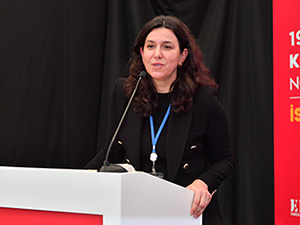A fifth of driver positions unfilled in the European road transport sector, according to IRU report
The European road transport sector is facing the most acute professional driver shortage in decades, a new report by the International Road Transport Union (IRU) has found.

21 Mart 2019 Perşembe 12:57
The report is based on insight from stakeholders across the European transport industry and drawn from two surveys conducted by IRU.
Polling of IRU members and associated organisations in Europe from October 2018 to January 2019 revealed a visible driver shortage of 21% in the freight transport sector and 19% in the bus and coach sector. The problem is accelerating, with the shortfall predicted to reach 40% in both sectors as demand grows in 2019.
Boris Blanche, IRU’s Managing Director commented: “The transport industry needs to take immediate and decisive action to tackle the driver shortage. Left unchecked, it will have serious implications for the European economy and lead to rising costs for businesses, consumers and passengers.
“But there is no shortage of opportunity in this profession. In fact, our research found that job satisfaction tends to be high, with only 20% of drivers surveyed expressing any dissatisfaction with their work.”
What’s causing the driver shortage?
According to IRU’s research:
- 57% of male drivers and 63% of female drivers believe the poor image of the profession is stifling recruitment.
- 79% of drivers believe the difficulty of attracting women to the profession is one of the top reasons for the driver shortage. This is underlined by data from the International Transport Forum, showing female drivers make up just 2% of European road transport drivers .
- 70% of drivers aged 25-34 believe the difficulty of attracting young drivers is one of top reasons for the driver shortage.
- Amongst drivers, 76% believe that working conditions, and 77% think long periods away from home deter many from entering the profession.
- The industry also suffers from an ageing labour force. In Europe the majority of freight transport sector companies are employing drivers whose average age is 44 years old, while in the passenger transport sector the average age of their employed drivers is 52 years old.
Mr Blanche continued, “A global effort must be made to address negative misperceptions and improve the image of the profession. At the same time, all industry stakeholders must act to improve working conditions in the sector. The treatment of drivers should be improved, with adequate and sufficient infrastructure and facilities provided.
“For industry to attract a new and diverse workforce, particularly increasing the employment of young people and women, a more inclusive recruitment policy must be put into place across the sector.”
The IRU Driver Shortage Road Map
To address these challenges, IRU has worked in close co-operation with its members to create an action plan of short, medium and long-term measures.
IRU has already taken steps, including the regular collection of solid company data, to find facts and monitor trends. It has launched a joint initiative with the European Shippers Council (ESC) to develop common principles aimed at improving the treatment of drivers at delivery sites. IRU has also established an expert group to address driver training legislation and its effectiveness.
IRU will set up a Women in Transport Network, aimed at increasing the number of women in the transport sector and their representation at all working levels as well as to promote transport as an attractive field for women to work in. It will contribute to incentives such as creating awards for female drivers and best performing companies in terms of recruitment, inclusiveness and retention.
Matthias Maedge, IRU’s General Delegate, warned: “Already the driver shortage is creating serious headaches for transport operators, impacting the people and businesses that rely on their services. Unfortunately, this is only set to worsen. We should not be fooled into thinking automation will solve this issue. There is still some way to go until the road transport industry sees full automation, and the partial adoption we are currently witnessing will require a sizeable workforce with an increasingly diverse skillset. This makes the need for decisive action to attract new talent all the more immediate.
“IRU has made the driver shortage one of its key priorities for 2019. We will work with public and private stakeholders such as national governments, local authorities, and social and industry partners to find solutions to address the impending crisis.”
Additional statistics
- In the UK, the country’s exit from the European Union arrives just as its shortage of drivers is estimated to be growing at a staggering rate of 50 drivers per day.
- The average driver age in Germany is now over 47, meaning that some 40% of the truck and 55% of bus driver workforce is expected to retire by 2027, creating a shortfall of around 185,000 drivers.
- In Belgium, bus operators estimate that the needs of the industry will require them to hire 28% more drivers than levels in 2018, resulting in a driver shortage of almost 50%.
- In Norway truck companies estimate that their demand for drivers will increase by 12% in 2019. Combined with the 22% vacancy rate identified in 2018, this will increase their driver shortage to 35%.
Truck companies in Romania faced a driver shortage of 37% in 2018 and indicated that 32% more drivers would be needed for growth in 2019, creating a driver shortage of almost 70% if the problem is not addressed.
![2025 Atlas Lojistik Ödülleri’ni Kazananlar Ne Dediler? - Melike Batur]() 2025 Atlas Lojistik Ödülleri’ni Kazananlar Ne Dediler? - Melike Batur2025 Atlas Lojistik Ödülleri yarışmasında “En Beğenilen Depo Yöneticisi (Online Oylama)” ödülünü alan Melike Batur’un tören sonrasında kameralarımıza yaptığı açıklamaları ekranlarınıza getiriyoruz.12 Aralık 2025 Cuma 13:15Lojistik
2025 Atlas Lojistik Ödülleri’ni Kazananlar Ne Dediler? - Melike Batur2025 Atlas Lojistik Ödülleri yarışmasında “En Beğenilen Depo Yöneticisi (Online Oylama)” ödülünü alan Melike Batur’un tören sonrasında kameralarımıza yaptığı açıklamaları ekranlarınıza getiriyoruz.12 Aralık 2025 Cuma 13:15Lojistik![Mercedes-Benz Türk Kayseri’de Heska ile Hizmet Ağını Genişletti]() Mercedes-Benz Türk Kayseri’de Heska ile Hizmet Ağını GenişlettiMercedes-Benz Türk, Heska Kayseri bayisini hizmete açarak bölgede satış ve servis ağını güçlendirdi.11 Aralık 2025 Perşembe 16:59Ticari Araçlar
Mercedes-Benz Türk Kayseri’de Heska ile Hizmet Ağını GenişlettiMercedes-Benz Türk, Heska Kayseri bayisini hizmete açarak bölgede satış ve servis ağını güçlendirdi.11 Aralık 2025 Perşembe 16:59Ticari Araçlar![2025 Atlas Lojistik Ödülleri’ni Kazananlar Ne Dediler? - BASF Türk]() 2025 Atlas Lojistik Ödülleri’ni Kazananlar Ne Dediler? - BASF TürkBASF Türkiye ve Orta Doğu, Gümrük ve Dış Ticaret Müdürü Güler Polat’ın Atlas Lojistik Ödülleri töreninde yaptığı açıklamaları ekranlarınıza getiriyoruz.11 Aralık 2025 Perşembe 15:37Ticari Araçlar
2025 Atlas Lojistik Ödülleri’ni Kazananlar Ne Dediler? - BASF TürkBASF Türkiye ve Orta Doğu, Gümrük ve Dış Ticaret Müdürü Güler Polat’ın Atlas Lojistik Ödülleri töreninde yaptığı açıklamaları ekranlarınıza getiriyoruz.11 Aralık 2025 Perşembe 15:37Ticari Araçlar![DP World Evyap Konteyner Elleçlemede 1 Milyon TEU Seviyesine Ulaştı]() DP World Evyap Konteyner Elleçlemede 1 Milyon TEU Seviyesine UlaştıDP World Evyap, 2025’te bir milyon TEU konteyner elleçleme eşiğini aşarak Türkiye’nin lojistik kapasitesindeki dönüşümün öncüsü oldu. İleri teknoloji yatırımlarıyla güçlenen terminal, bölgesel ticarette yeni bir büyüme döneminin kapılarını aralıyor.11 Aralık 2025 Perşembe 10:03Denizcilik
DP World Evyap Konteyner Elleçlemede 1 Milyon TEU Seviyesine UlaştıDP World Evyap, 2025’te bir milyon TEU konteyner elleçleme eşiğini aşarak Türkiye’nin lojistik kapasitesindeki dönüşümün öncüsü oldu. İleri teknoloji yatırımlarıyla güçlenen terminal, bölgesel ticarette yeni bir büyüme döneminin kapılarını aralıyor.11 Aralık 2025 Perşembe 10:03Denizcilik![Shell & Turcas Filoları Geleceğe Taşıyan Çözümlerini logitrans 2025’te Tanıttı]() Shell & Turcas Filoları Geleceğe Taşıyan Çözümlerini logitrans 2025’te Tanıttı“İşi için yolda olan insanların Shell’i” mottosuyla faaliyetlerini sürdüren Shell Filo Çözümleri, lojistik sektörünün en önemli buluşmalarından Uluslararası logitrans Transport Lojistik Fuarı’nda yerini aldı.10 Aralık 2025 Çarşamba 16:44Lojistik
Shell & Turcas Filoları Geleceğe Taşıyan Çözümlerini logitrans 2025’te Tanıttı“İşi için yolda olan insanların Shell’i” mottosuyla faaliyetlerini sürdüren Shell Filo Çözümleri, lojistik sektörünün en önemli buluşmalarından Uluslararası logitrans Transport Lojistik Fuarı’nda yerini aldı.10 Aralık 2025 Çarşamba 16:44Lojistik![Yerli Üretim Peugeot Expert Traveller Yollara Çıkıyor]() Yerli Üretim Peugeot Expert Traveller Yollara ÇıkıyorBursa’daki Tofaş tesisinde üretimi başlayan Expert Traveller, güçlü donanımı ve 2.2 BlueHDi motoruyla Türkiye yollarına çıkmaya hazırlanıyor.10 Aralık 2025 Çarşamba 13:56Ticari Araçlar
Yerli Üretim Peugeot Expert Traveller Yollara ÇıkıyorBursa’daki Tofaş tesisinde üretimi başlayan Expert Traveller, güçlü donanımı ve 2.2 BlueHDi motoruyla Türkiye yollarına çıkmaya hazırlanıyor.10 Aralık 2025 Çarşamba 13:56Ticari Araçlar![Samsun Büyükşehir Acil Sağlık Filosu Volkswagen Crafter ile Güçlendi]() Samsun Büyükşehir Acil Sağlık Filosu Volkswagen Crafter ile GüçlendiSamsun Büyükşehir Belediyesi, 100 ambulans ve 5 hasta nakil aracı olmak üzere toplam 105 adet Volkswagen Crafter aracı filosuna dahil ederek şehrin acil sağlık hizmetlerinde kapasite artışı sağladı.09 Aralık 2025 Salı 16:55Ticari Araçlar
Samsun Büyükşehir Acil Sağlık Filosu Volkswagen Crafter ile GüçlendiSamsun Büyükşehir Belediyesi, 100 ambulans ve 5 hasta nakil aracı olmak üzere toplam 105 adet Volkswagen Crafter aracı filosuna dahil ederek şehrin acil sağlık hizmetlerinde kapasite artışı sağladı.09 Aralık 2025 Salı 16:55Ticari Araçlar![İzmir İtfaiyesi Hızlı Müdahalede Tam Otomatiği Tercih Ediyor]() İzmir İtfaiyesi Hızlı Müdahalede Tam Otomatiği Tercih Ediyorİzmir Büyükşehir Belediyesi İtfaiye Dairesi Başkanlığı araç filosunda bulunan Allison 3000™serisi tam otomatik şanzıman donanımlı kamyonlar, yangın ve acil durum mahallerine hızlı ve güvenilir erişimi destekliyor.09 Aralık 2025 Salı 16:39Ticari Araçlar
İzmir İtfaiyesi Hızlı Müdahalede Tam Otomatiği Tercih Ediyorİzmir Büyükşehir Belediyesi İtfaiye Dairesi Başkanlığı araç filosunda bulunan Allison 3000™serisi tam otomatik şanzıman donanımlı kamyonlar, yangın ve acil durum mahallerine hızlı ve güvenilir erişimi destekliyor.09 Aralık 2025 Salı 16:39Ticari Araçlar![Sürat Lojistik Avrupa Yapılanmasına Hazırlanıyor]() Sürat Lojistik Avrupa Yapılanmasına HazırlanıyorYurt içinde kısa sürede güçlü bir büyüme yakalayan Sürat Lojistik, yurt dışında doğrudan yapılanma hedefiyle Doğu Avrupa’ya odaklanıyor. Şirket, Polonya ve Romanya’yı Avrupa’daki ilk operasyonel adım olarak konumlandırıyor.09 Aralık 2025 Salı 16:05Lojistik
Sürat Lojistik Avrupa Yapılanmasına HazırlanıyorYurt içinde kısa sürede güçlü bir büyüme yakalayan Sürat Lojistik, yurt dışında doğrudan yapılanma hedefiyle Doğu Avrupa’ya odaklanıyor. Şirket, Polonya ve Romanya’yı Avrupa’daki ilk operasyonel adım olarak konumlandırıyor.09 Aralık 2025 Salı 16:05Lojistik![IATA Hava Kargodaki Büyümenin Devam Edeceğini ve 2026’da Gelirlerin 158 Milyar Dolar Olacağını Öngörüyor]() IATA Hava Kargodaki Büyümenin Devam Edeceğini ve 2026’da Gelirlerin 158 Milyar Dolar Olacağını ÖngörüyorUluslararası Hava Taşımacılığı Birliği (IATA), tedarik zinciri sorunları sürerken küresel havayolu endüstrisinin kârlılığının dengelendiğini gösteren en son finansal görünümünü ve 2026 öngörülerini yayımladı.09 Aralık 2025 Salı 14:59Havayolu
IATA Hava Kargodaki Büyümenin Devam Edeceğini ve 2026’da Gelirlerin 158 Milyar Dolar Olacağını ÖngörüyorUluslararası Hava Taşımacılığı Birliği (IATA), tedarik zinciri sorunları sürerken küresel havayolu endüstrisinin kârlılığının dengelendiğini gösteren en son finansal görünümünü ve 2026 öngörülerini yayımladı.09 Aralık 2025 Salı 14:59Havayolu
- Geri
- Ana Sayfa
- Normal Görünüm
- © 2025 Kargo Haber


















Türkçe karakter kullanılmayan ve büyük harflerle yazılmış yorumlar onaylanmamaktadır.